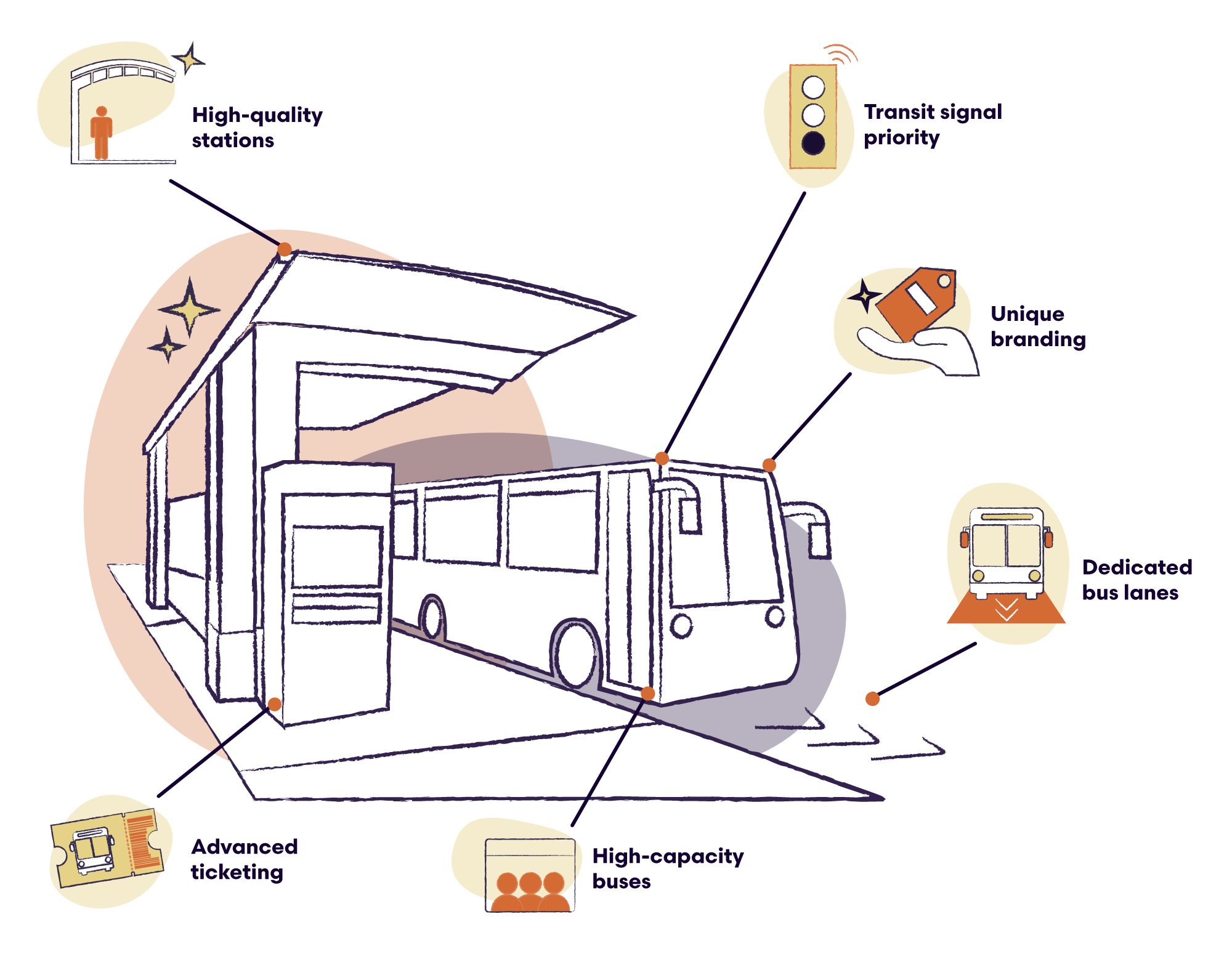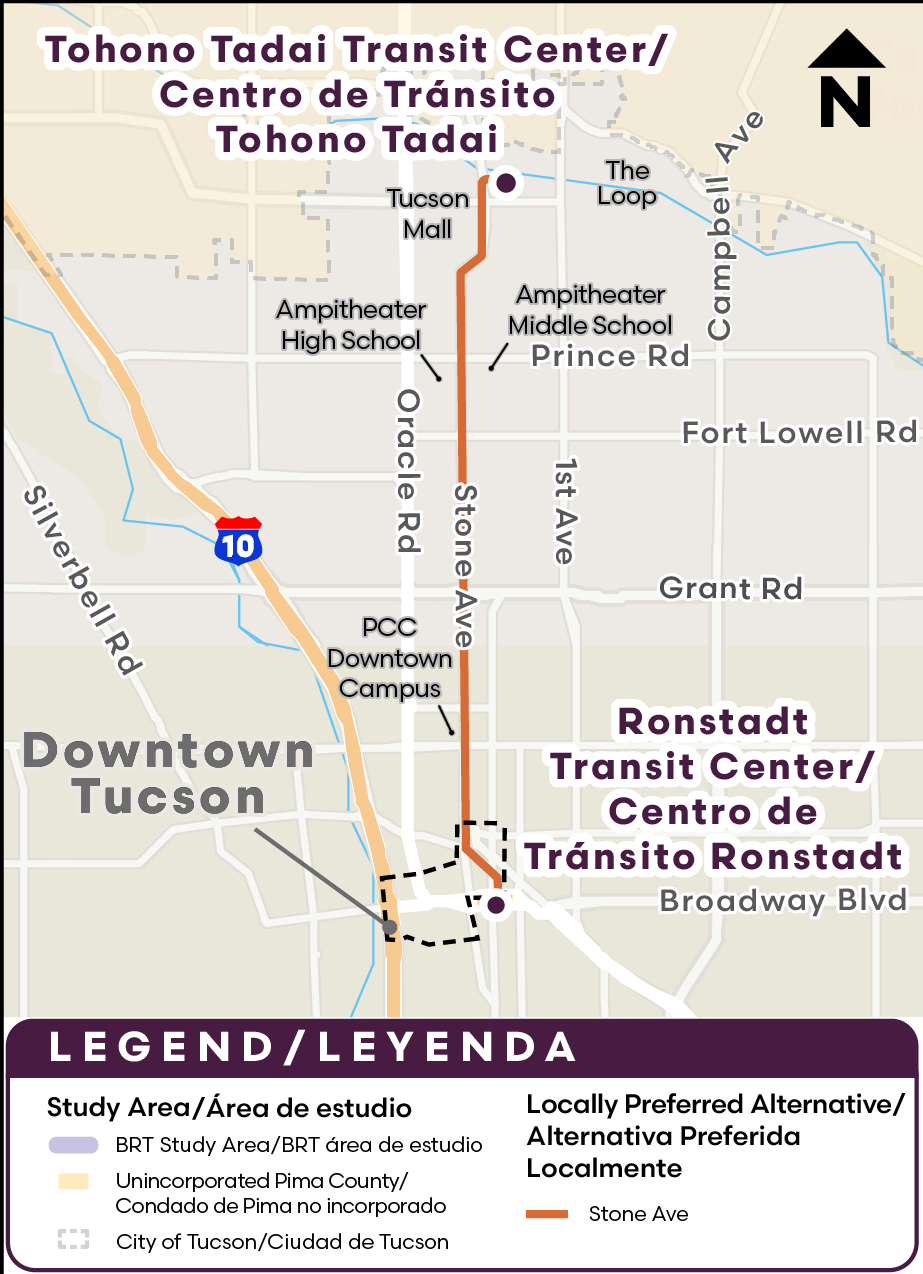- The first segment of this project, the north segment, will be Bus Rapid Transit (BRT) along Stone Avenue.
- During a survey conducted in Fall 2023, a majority of respondents preferred a BRT route along Stone Avenue over Oracle Road.
- In early 2024, Mayor and Council approved Stone Avenue as the Locally Preferred Alternative.
- The north segment is expected to be built between 2026 and 2030.
North
The north segment is a five-mile corridor that will connect people and places between the Tohono Tadai Transit Center/Tucson Mall and the downtown Ronstadt Transit Center.
What We’ve Heard
2024
Community Outreach for Stone Avenue Bus Rapid Transit (BRT) took place in Fall 2024. This outreach phase included a survey that sought community input on station locations, elements, and amenities. Community input was collected from October 9, 2024, through December 8, 2024. Here’s what we heard:
-
Most people who responded to an open-ended question about
preferred station elements want to see the following:
- Shade (63%)
- Landscaping (25%)
- Bike lockers (14%)
- Public art (14%)
More information on outreach efforts, survey responses and comments received can be found in our Community Outreach Phase III Summary Memo.
2023
Community outreach for the north segment of the corridor began in Fall 2023. It included a survey seeking community input on preferences for a BRT corridor, as well as priorities for BRT riders and bus lane options. Here’s what we heard:
- 61% of respondents said they prefer a BRT route along Stone Avenue.
- When asked to select what was most important to potential BRT riders, transit speed and reliability came in first, followed by pedestrian or bicycle access, and safety and security.
- When asked to rank the evaluation criteria for the next phase of analysis, respondents chose BRT travel time, bike and pedestrian facilities, and ridership.
More information on outreach efforts, survey responses and comments received can be found in our Public Outreach Phase 1 Memo, Executive Summary (English) / Executive Summary (Spanish), and Mayor and Council Presentation – January 2024
Fast Facts
What is BRT?
Bus Rapid Transit (BRT) is a high-capacity bus service that improves travel speed, reliability, passenger capacity, and the rider experience.
Why BRT?
BRT provides a more cost-efficient and enhanced transit experience compared to the local transit services offered. BRT can be planned, designed, and implemented at a much lower cost than other high-capacity transit services, while still offering an improved rider experience through enhanced stations, dedicated lanes, transit signal priority, and high rider capacity.
BRT Elements

BRT Benefits
There are many benefits to BRT systems, including transit improvements, safety, public and environmental health, and economic development. BRT systems are proven to save travel time, reduce greenhouse gas emissions, and improve traffic safety. They provide significantly faster operating speeds, greater service reliability, and increased convenience for passengers. Benefits may include:
Increased Safety
Dedicated BRT bus lanes increase safety by reducing the risk of collisions with other vehicles.
Faster and More Frequent Service
BRT is faster and provides more frequent service than traditional bus routes.
Improved Boarding Experience
Through enhanced rider amenities such as larger transit vehicles, off-board fare collection, level-boarding platforms, and multiple-door boarding, BRT can improve the overall travel experience and increase travel speed by reducing boarding times.
Increased Cost Efficiency
BRT reduces operational costs as vehicles make fewer stops, have increased travel speed, and can carry more passengers, ultimately reducing the number of vehicles needed.
Improved Connectivity to Key Destinations
BRT will provide more efficient connections to key destinations and enhance the overall transit network by creating more frequent connections to other transit routes.
